The Role of Communication in Person-Centred Care and Patient Safety
VerifiedAdded on 2023/04/24
|13
|3362
|493
Essay
AI Summary
This essay delves into the critical aspects of person-centred care within nursing, emphasizing the significance of effective communication and its direct impact on patient safety. It explores how person-centred care, built on respect and trust, necessitates healthcare professionals to be skilled and knowledgeable, understanding both the spiritual and physical needs of the person through comprehensive assessments. The essay further discusses the barriers to person-centred care, such as time constraints and the complexity of healthcare environments, while highlighting the importance of therapeutic relationships and clear communication in fostering patient empowerment and improving overall satisfaction. It also examines the role of values in communication, emphasizing the need for active listening and feedback from patients and their families. Furthermore, the essay underscores the importance of patient safety, defining it as a set of actions to protect healthcare service users from harm, including psychological, cultural, and emotional safety, and emphasizes the need for healthcare professionals to enhance their interpersonal communication skills to navigate the challenges of contemporary healthcare systems. This resource is available on Desklib, a platform offering various study tools and solved assignments for students.
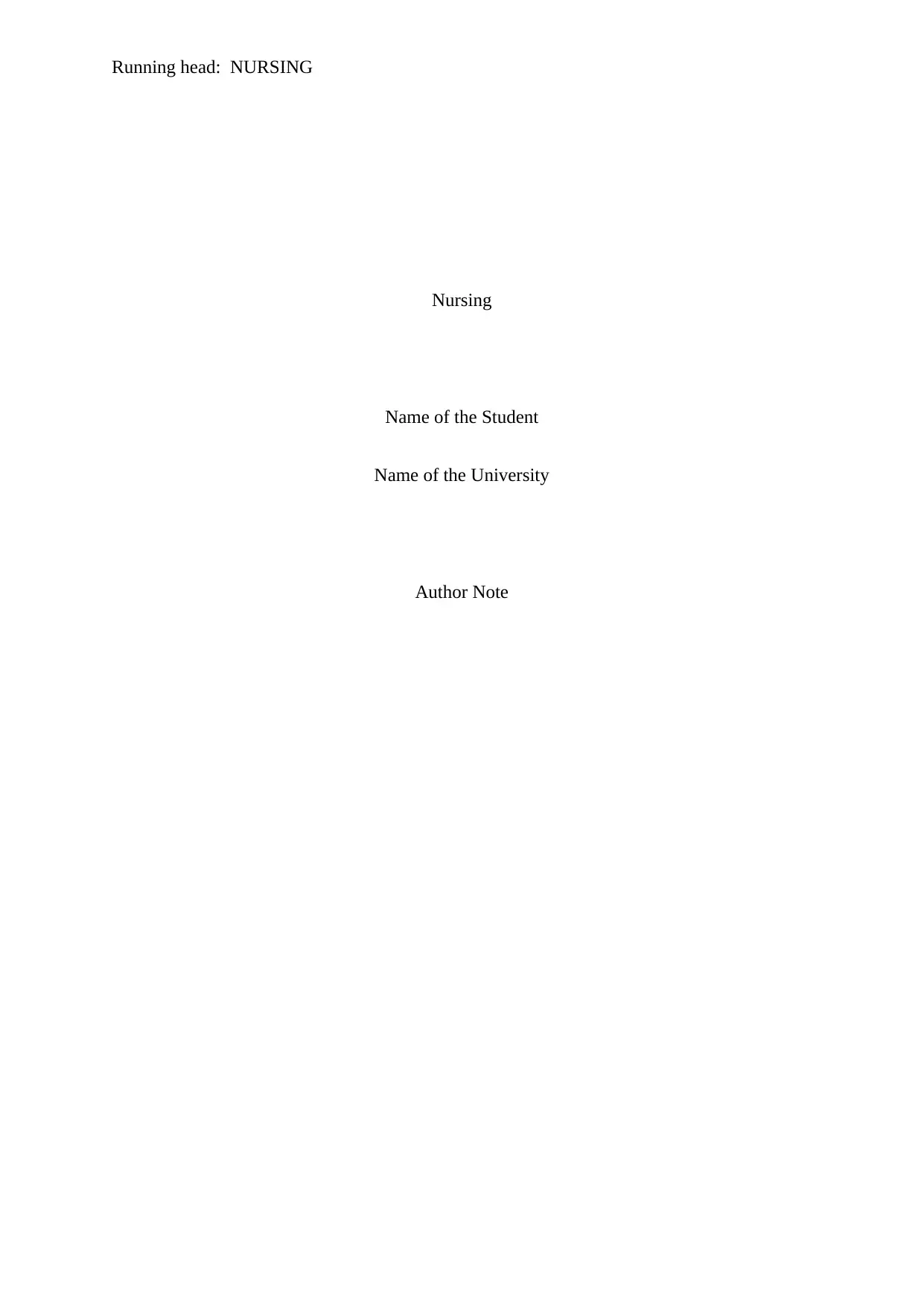
Running head: NURSING
Nursing
Name of the Student
Name of the University
Author Note
Nursing
Name of the Student
Name of the University
Author Note
Paraphrase This Document
Need a fresh take? Get an instant paraphrase of this document with our AI Paraphraser

1
NURSING
Reading 1
Person-centred care
Person-centred care occurs when personhood and person-centeredness is used to
deliver care to patients across a wide-range of settings. Person-centred care mainly deals with
respect and trust and is important under diverse healthcare settings, mental health,
community-based family practice and maternity care.
Person-centred care is recognises individuality such that the care provided is in direct
response to comprehensive need of the person. Thus healthcare-professionals need to be
knowledgeable and skilled about person-centred care approach. However, person-centred
care is beyond individualising care through done through preliminary adjustments in the
physical care. Individualised care permeates under all aspects of care and coincides with the
beliefs and values of the service user and thus requires knowing the both spiritual and
physical needs of the person. For example, in order to deliver person-centred care, proper
assessment must be conducted in order to the known the story of the service users and the
exact needs. These needs can be both healthcare needs, mental needs and spiritual needs.
Interaction or intervention for each individual should be considered for providing
social justice and under the spirit of partnership. This approach of partnership necessitates
empowerment, sharing of power by accepting the acknowledging the ethical rights of
autonomy of service users and thereby helping to engage the service users in the informed
decision-making process. This helps to bring patient empowerment in the decision making
process.
There are enough evidences, which suggest that the person-centred care approach is a
holistic approach which helps to increase the overall level of satisfaction of the service users.
NURSING
Reading 1
Person-centred care
Person-centred care occurs when personhood and person-centeredness is used to
deliver care to patients across a wide-range of settings. Person-centred care mainly deals with
respect and trust and is important under diverse healthcare settings, mental health,
community-based family practice and maternity care.
Person-centred care is recognises individuality such that the care provided is in direct
response to comprehensive need of the person. Thus healthcare-professionals need to be
knowledgeable and skilled about person-centred care approach. However, person-centred
care is beyond individualising care through done through preliminary adjustments in the
physical care. Individualised care permeates under all aspects of care and coincides with the
beliefs and values of the service user and thus requires knowing the both spiritual and
physical needs of the person. For example, in order to deliver person-centred care, proper
assessment must be conducted in order to the known the story of the service users and the
exact needs. These needs can be both healthcare needs, mental needs and spiritual needs.
Interaction or intervention for each individual should be considered for providing
social justice and under the spirit of partnership. This approach of partnership necessitates
empowerment, sharing of power by accepting the acknowledging the ethical rights of
autonomy of service users and thereby helping to engage the service users in the informed
decision-making process. This helps to bring patient empowerment in the decision making
process.
There are enough evidences, which suggest that the person-centred care approach is a
holistic approach which helps to increase the overall level of satisfaction of the service users.
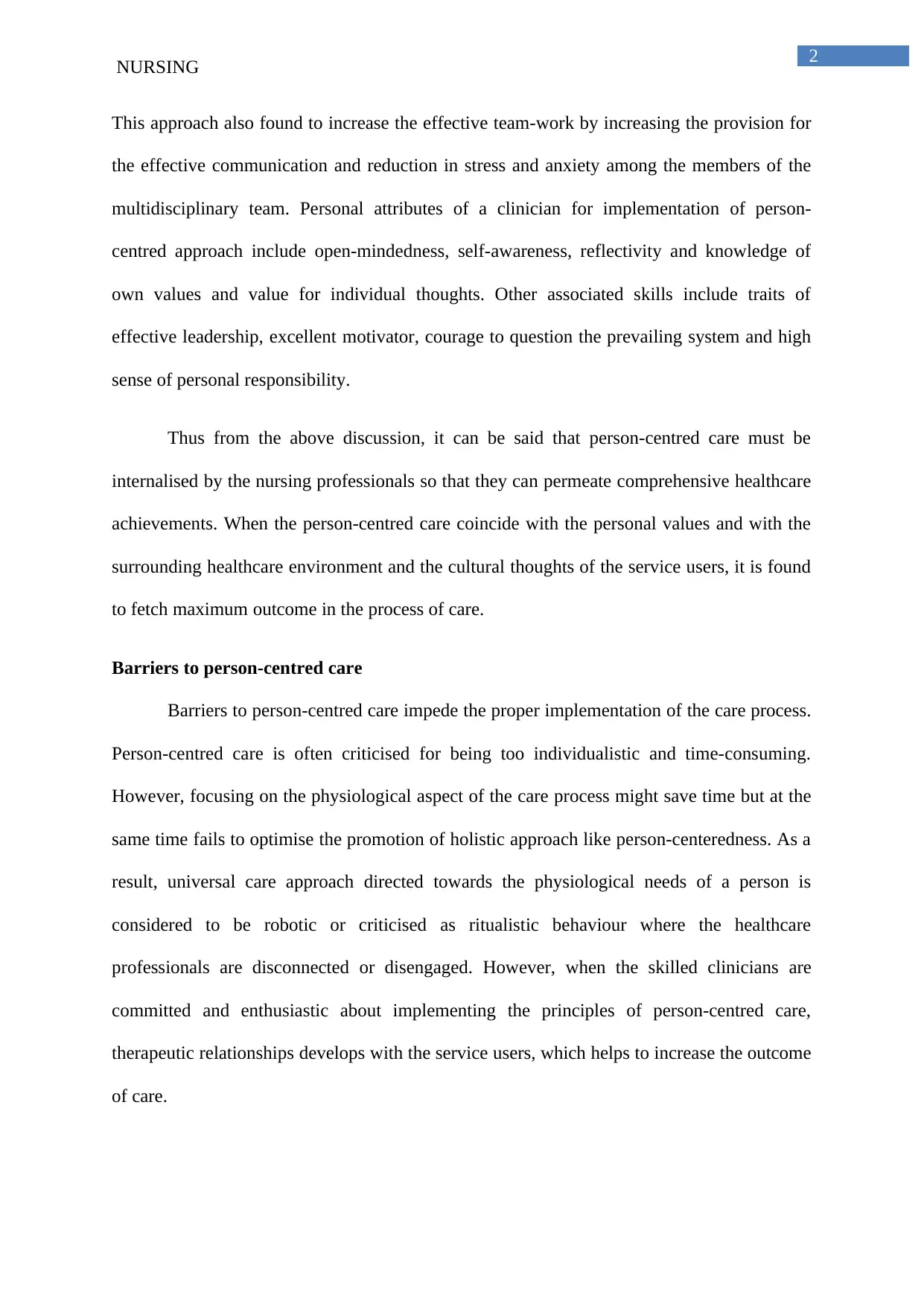
2
NURSING
This approach also found to increase the effective team-work by increasing the provision for
the effective communication and reduction in stress and anxiety among the members of the
multidisciplinary team. Personal attributes of a clinician for implementation of person-
centred approach include open-mindedness, self-awareness, reflectivity and knowledge of
own values and value for individual thoughts. Other associated skills include traits of
effective leadership, excellent motivator, courage to question the prevailing system and high
sense of personal responsibility.
Thus from the above discussion, it can be said that person-centred care must be
internalised by the nursing professionals so that they can permeate comprehensive healthcare
achievements. When the person-centred care coincide with the personal values and with the
surrounding healthcare environment and the cultural thoughts of the service users, it is found
to fetch maximum outcome in the process of care.
Barriers to person-centred care
Barriers to person-centred care impede the proper implementation of the care process.
Person-centred care is often criticised for being too individualistic and time-consuming.
However, focusing on the physiological aspect of the care process might save time but at the
same time fails to optimise the promotion of holistic approach like person-centeredness. As a
result, universal care approach directed towards the physiological needs of a person is
considered to be robotic or criticised as ritualistic behaviour where the healthcare
professionals are disconnected or disengaged. However, when the skilled clinicians are
committed and enthusiastic about implementing the principles of person-centred care,
therapeutic relationships develops with the service users, which helps to increase the outcome
of care.
NURSING
This approach also found to increase the effective team-work by increasing the provision for
the effective communication and reduction in stress and anxiety among the members of the
multidisciplinary team. Personal attributes of a clinician for implementation of person-
centred approach include open-mindedness, self-awareness, reflectivity and knowledge of
own values and value for individual thoughts. Other associated skills include traits of
effective leadership, excellent motivator, courage to question the prevailing system and high
sense of personal responsibility.
Thus from the above discussion, it can be said that person-centred care must be
internalised by the nursing professionals so that they can permeate comprehensive healthcare
achievements. When the person-centred care coincide with the personal values and with the
surrounding healthcare environment and the cultural thoughts of the service users, it is found
to fetch maximum outcome in the process of care.
Barriers to person-centred care
Barriers to person-centred care impede the proper implementation of the care process.
Person-centred care is often criticised for being too individualistic and time-consuming.
However, focusing on the physiological aspect of the care process might save time but at the
same time fails to optimise the promotion of holistic approach like person-centeredness. As a
result, universal care approach directed towards the physiological needs of a person is
considered to be robotic or criticised as ritualistic behaviour where the healthcare
professionals are disconnected or disengaged. However, when the skilled clinicians are
committed and enthusiastic about implementing the principles of person-centred care,
therapeutic relationships develops with the service users, which helps to increase the outcome
of care.
⊘ This is a preview!⊘
Do you want full access?
Subscribe today to unlock all pages.

Trusted by 1+ million students worldwide

3
NURSING
The main principles that underline the person-centred care approach are at times
criticised for being optimistic and idealistic and considered difficult to achieve under
complex healthcare environments where there is constant work pressure and tress. However,
healthcare environments must be as therapeutic for example; physical surroundings must
respect the dignity and privacy of the service users so that their sense of threat is not
threatened. However, person-centred care is not only associated with the physical
surroundings it also takes into consideration the cultural environment. A flexible and
supportive atmosphere makes it easier for the service users to navigate swiftly to for their
needs. A flexible work environment also helps the healthcare professionals to act
autonomously and participate in effective decision making process by recognising
innovation. However, the majority of the healthcare environments are complex and large and
do not promote person-centeredness because the schedules and routines of check-up is given
first priority. However, implementing person-centred care is not impossible to implement in
large healthcare organisation what is require is commitment towards its principles.
Furthermore, when there is poor co-ordination and integration between the services, the
disorganisation might result in the generation or care plan which disregards the importance of
the person’s partnership and opinion.
NURSING
The main principles that underline the person-centred care approach are at times
criticised for being optimistic and idealistic and considered difficult to achieve under
complex healthcare environments where there is constant work pressure and tress. However,
healthcare environments must be as therapeutic for example; physical surroundings must
respect the dignity and privacy of the service users so that their sense of threat is not
threatened. However, person-centred care is not only associated with the physical
surroundings it also takes into consideration the cultural environment. A flexible and
supportive atmosphere makes it easier for the service users to navigate swiftly to for their
needs. A flexible work environment also helps the healthcare professionals to act
autonomously and participate in effective decision making process by recognising
innovation. However, the majority of the healthcare environments are complex and large and
do not promote person-centeredness because the schedules and routines of check-up is given
first priority. However, implementing person-centred care is not impossible to implement in
large healthcare organisation what is require is commitment towards its principles.
Furthermore, when there is poor co-ordination and integration between the services, the
disorganisation might result in the generation or care plan which disregards the importance of
the person’s partnership and opinion.
Paraphrase This Document
Need a fresh take? Get an instant paraphrase of this document with our AI Paraphraser
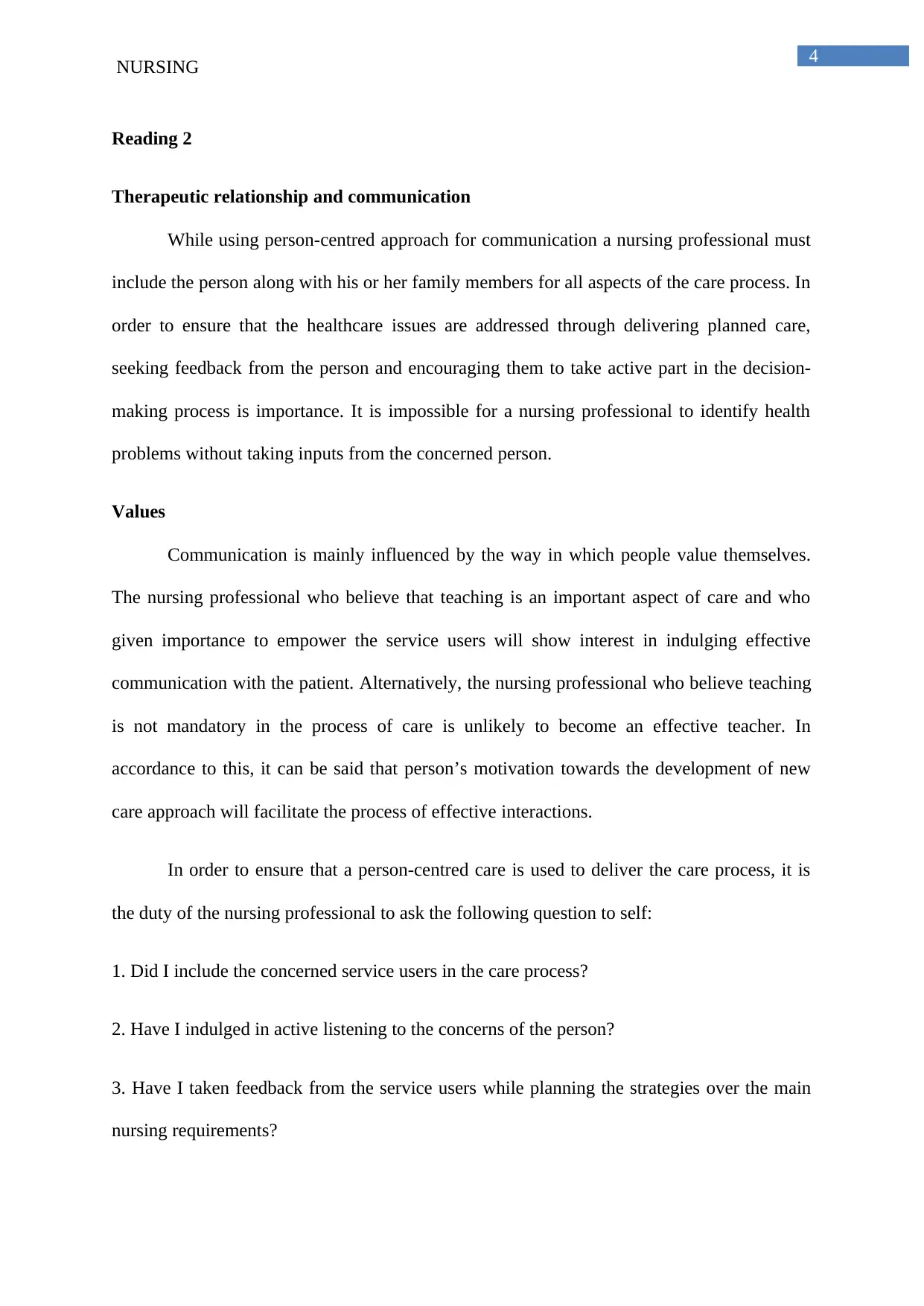
4
NURSING
Reading 2
Therapeutic relationship and communication
While using person-centred approach for communication a nursing professional must
include the person along with his or her family members for all aspects of the care process. In
order to ensure that the healthcare issues are addressed through delivering planned care,
seeking feedback from the person and encouraging them to take active part in the decision-
making process is importance. It is impossible for a nursing professional to identify health
problems without taking inputs from the concerned person.
Values
Communication is mainly influenced by the way in which people value themselves.
The nursing professional who believe that teaching is an important aspect of care and who
given importance to empower the service users will show interest in indulging effective
communication with the patient. Alternatively, the nursing professional who believe teaching
is not mandatory in the process of care is unlikely to become an effective teacher. In
accordance to this, it can be said that person’s motivation towards the development of new
care approach will facilitate the process of effective interactions.
In order to ensure that a person-centred care is used to deliver the care process, it is
the duty of the nursing professional to ask the following question to self:
1. Did I include the concerned service users in the care process?
2. Have I indulged in active listening to the concerns of the person?
3. Have I taken feedback from the service users while planning the strategies over the main
nursing requirements?
NURSING
Reading 2
Therapeutic relationship and communication
While using person-centred approach for communication a nursing professional must
include the person along with his or her family members for all aspects of the care process. In
order to ensure that the healthcare issues are addressed through delivering planned care,
seeking feedback from the person and encouraging them to take active part in the decision-
making process is importance. It is impossible for a nursing professional to identify health
problems without taking inputs from the concerned person.
Values
Communication is mainly influenced by the way in which people value themselves.
The nursing professional who believe that teaching is an important aspect of care and who
given importance to empower the service users will show interest in indulging effective
communication with the patient. Alternatively, the nursing professional who believe teaching
is not mandatory in the process of care is unlikely to become an effective teacher. In
accordance to this, it can be said that person’s motivation towards the development of new
care approach will facilitate the process of effective interactions.
In order to ensure that a person-centred care is used to deliver the care process, it is
the duty of the nursing professional to ask the following question to self:
1. Did I include the concerned service users in the care process?
2. Have I indulged in active listening to the concerns of the person?
3. Have I taken feedback from the service users while planning the strategies over the main
nursing requirements?

5
NURSING
4. Are the strategies framed are appropriate for the person?
5. Have I included the family members of the person in the process of framing the therapy?
Using therapeutic-communication for the development of person-centred relationship
The majority of the healthcare professionals enter in this profession in order to help
people. The majority of the healthcare professionals and the people who avail care are not
accomplished randomly but there exists purposeful relationships. A person-centred
relationship exists among the people who provide and receive assistance in order to meet
daily human needs. Here person-centred relationship is used to define the relationship
between the healthcare service users and the service providers. This relationship help to
progress towards a common goal that is meeting the healthcare needs of the service users.
The importance of the therapeutic relationship is defined by the effectiveness of the
car process. One of the common problems in this care process is failure in establishing the
rapport and gap in developing healthy therapeutic relationship.
Person-centred relationship and social relationship
Friendship and person-centred relationship shares some common qualities like care,
concern, trust and growth. However, there are few differences as well.
1. The person-centred relationship occurs with a person for specific reason
2. The person-centred relationship is defined by unequal sharing of information. The service
users’ share information associated with the personal health-related problems. On the other-
hand, the nursing professionals and the midwives shares the information defining their
professional role in practice. This is something different from the social relationship like
friendship where the information sharing is defined by quantity, type and is of equal value
under the shared responsibility.
NURSING
4. Are the strategies framed are appropriate for the person?
5. Have I included the family members of the person in the process of framing the therapy?
Using therapeutic-communication for the development of person-centred relationship
The majority of the healthcare professionals enter in this profession in order to help
people. The majority of the healthcare professionals and the people who avail care are not
accomplished randomly but there exists purposeful relationships. A person-centred
relationship exists among the people who provide and receive assistance in order to meet
daily human needs. Here person-centred relationship is used to define the relationship
between the healthcare service users and the service providers. This relationship help to
progress towards a common goal that is meeting the healthcare needs of the service users.
The importance of the therapeutic relationship is defined by the effectiveness of the
car process. One of the common problems in this care process is failure in establishing the
rapport and gap in developing healthy therapeutic relationship.
Person-centred relationship and social relationship
Friendship and person-centred relationship shares some common qualities like care,
concern, trust and growth. However, there are few differences as well.
1. The person-centred relationship occurs with a person for specific reason
2. The person-centred relationship is defined by unequal sharing of information. The service
users’ share information associated with the personal health-related problems. On the other-
hand, the nursing professionals and the midwives shares the information defining their
professional role in practice. This is something different from the social relationship like
friendship where the information sharing is defined by quantity, type and is of equal value
under the shared responsibility.
⊘ This is a preview!⊘
Do you want full access?
Subscribe today to unlock all pages.

Trusted by 1+ million students worldwide

6
NURSING
3. Person-centred relationship is developed on the basis of the exact requirement of the
healthcare service user and not upon the need of the healthcare provider. In friendship, the
requirement of both the friends is considered. A friendship might grow out of the therapeutic
relationship or person-centred relationship however, this is different from the purposeful and
the time-restricted interaction pertinent to this relationship status.
It is of prime importance that the midwives and the nursing professional must keep in
mind that purpose of the development of the therapeutic relationship is solely due to
professional purpose. Such that professional relationships have certain boundaries and these
boundaries are important to recognise. Crossing these professional boundaries might result in
sound disciplinary action against the concerned professional. Crossing the professional
boundaries under the development of the therapeutic relations occurs when the nursing
professional breaches the ethical issues of the privacy, confidentiality.
It can be helpful for the novice nursing professionals and aspiring nursing students
and midwives to identify and work on their skills of effective communication under the clear
sense of professionalism. The sense of professionalism is defined as a manner under which
the nursing professionals want to conduct themselves. The majority of the everyday person-
centred relationship coincides with the social relationships and at times consist of a simple
casual chat about any diverse topic like sports or weather. However, there is always an
awareness of the exact requirement of the person’s needs and thus intense therapeutic
approach is adopted, dealing with more in-depth issues in a way that promotes confidence
and trust irrespective of the care process. A person or the healthcare service user is more
likely to trust and value the midwives and the nurses who appear to them competent and
confident and those who are focused in giving importance to their (healthcare service users’)
exact needs (person-centred care approach).
NURSING
3. Person-centred relationship is developed on the basis of the exact requirement of the
healthcare service user and not upon the need of the healthcare provider. In friendship, the
requirement of both the friends is considered. A friendship might grow out of the therapeutic
relationship or person-centred relationship however, this is different from the purposeful and
the time-restricted interaction pertinent to this relationship status.
It is of prime importance that the midwives and the nursing professional must keep in
mind that purpose of the development of the therapeutic relationship is solely due to
professional purpose. Such that professional relationships have certain boundaries and these
boundaries are important to recognise. Crossing these professional boundaries might result in
sound disciplinary action against the concerned professional. Crossing the professional
boundaries under the development of the therapeutic relations occurs when the nursing
professional breaches the ethical issues of the privacy, confidentiality.
It can be helpful for the novice nursing professionals and aspiring nursing students
and midwives to identify and work on their skills of effective communication under the clear
sense of professionalism. The sense of professionalism is defined as a manner under which
the nursing professionals want to conduct themselves. The majority of the everyday person-
centred relationship coincides with the social relationships and at times consist of a simple
casual chat about any diverse topic like sports or weather. However, there is always an
awareness of the exact requirement of the person’s needs and thus intense therapeutic
approach is adopted, dealing with more in-depth issues in a way that promotes confidence
and trust irrespective of the care process. A person or the healthcare service user is more
likely to trust and value the midwives and the nurses who appear to them competent and
confident and those who are focused in giving importance to their (healthcare service users’)
exact needs (person-centred care approach).
Paraphrase This Document
Need a fresh take? Get an instant paraphrase of this document with our AI Paraphraser

7
NURSING
Reading 3
Patient Safety and Communication
According to the National Patient Safety Foundation, published in the year 2008, The
term patient safety is defined as a set of action that are undertaken by healthcare professionals
or the healthcare organisations in order to protect the health care service users from getting
harmed by the healthcare. It is important to take into consideration that the act of safety of the
patient is not limited to the physical safety only. The component of physical safety is also
associated with the psychological, cultural and the emotional safety of the healthcare service
users. The patient safety is mainly defined as a trait of a trustworthy healthcare system that
works to reduce the rate of occurrence and impact of the adverse events and also work to
maximize the recovery of the patients who are the victims of the adverse events. Patient
safety is regarded as one of the important issues in the present day healthcare setup. The
healthcare professionals must effective work on their inter-personal communication skills
(verbal and non-verbal communication skills) in order to handle the impending tensions
prevailing in the contemporary healthcare systems like increase in the patient load, poor
nurse: patient ratio, stress and anxiety in the workplace or demanding patients and non-
cooperative family members of the patient.
Communication is considered to be much important than creating the provision of the
healthcare information, advise or the instructions. It is an effective communication is defined
as a two-way interaction where the flow of the information occurs from both the participants
either verbally or non-verbally along with exchange of feelings. A successful communication
is achieved when the message that is being conveyed is understood by the recipients as
intended. However, in the healthcare sectors, in effective communication, the service users or
the patients are the prime person who shares the information on covey their concerns and it is
the duty of the nursing professionals to understand the information as intended by the client,
NURSING
Reading 3
Patient Safety and Communication
According to the National Patient Safety Foundation, published in the year 2008, The
term patient safety is defined as a set of action that are undertaken by healthcare professionals
or the healthcare organisations in order to protect the health care service users from getting
harmed by the healthcare. It is important to take into consideration that the act of safety of the
patient is not limited to the physical safety only. The component of physical safety is also
associated with the psychological, cultural and the emotional safety of the healthcare service
users. The patient safety is mainly defined as a trait of a trustworthy healthcare system that
works to reduce the rate of occurrence and impact of the adverse events and also work to
maximize the recovery of the patients who are the victims of the adverse events. Patient
safety is regarded as one of the important issues in the present day healthcare setup. The
healthcare professionals must effective work on their inter-personal communication skills
(verbal and non-verbal communication skills) in order to handle the impending tensions
prevailing in the contemporary healthcare systems like increase in the patient load, poor
nurse: patient ratio, stress and anxiety in the workplace or demanding patients and non-
cooperative family members of the patient.
Communication is considered to be much important than creating the provision of the
healthcare information, advise or the instructions. It is an effective communication is defined
as a two-way interaction where the flow of the information occurs from both the participants
either verbally or non-verbally along with exchange of feelings. A successful communication
is achieved when the message that is being conveyed is understood by the recipients as
intended. However, in the healthcare sectors, in effective communication, the service users or
the patients are the prime person who shares the information on covey their concerns and it is
the duty of the nursing professionals to understand the information as intended by the client,
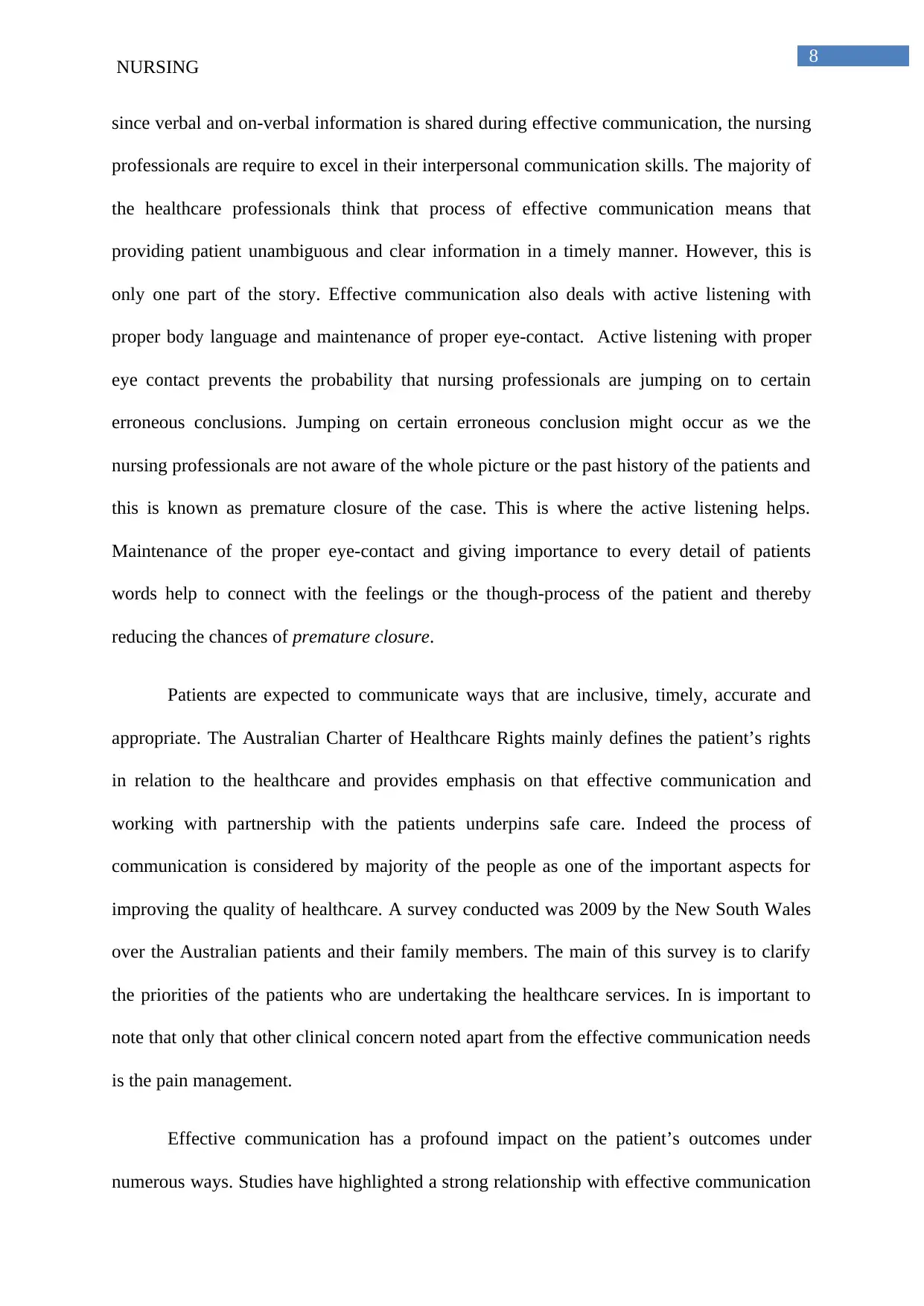
8
NURSING
since verbal and on-verbal information is shared during effective communication, the nursing
professionals are require to excel in their interpersonal communication skills. The majority of
the healthcare professionals think that process of effective communication means that
providing patient unambiguous and clear information in a timely manner. However, this is
only one part of the story. Effective communication also deals with active listening with
proper body language and maintenance of proper eye-contact. Active listening with proper
eye contact prevents the probability that nursing professionals are jumping on to certain
erroneous conclusions. Jumping on certain erroneous conclusion might occur as we the
nursing professionals are not aware of the whole picture or the past history of the patients and
this is known as premature closure of the case. This is where the active listening helps.
Maintenance of the proper eye-contact and giving importance to every detail of patients
words help to connect with the feelings or the though-process of the patient and thereby
reducing the chances of premature closure.
Patients are expected to communicate ways that are inclusive, timely, accurate and
appropriate. The Australian Charter of Healthcare Rights mainly defines the patient’s rights
in relation to the healthcare and provides emphasis on that effective communication and
working with partnership with the patients underpins safe care. Indeed the process of
communication is considered by majority of the people as one of the important aspects for
improving the quality of healthcare. A survey conducted was 2009 by the New South Wales
over the Australian patients and their family members. The main of this survey is to clarify
the priorities of the patients who are undertaking the healthcare services. In is important to
note that only that other clinical concern noted apart from the effective communication needs
is the pain management.
Effective communication has a profound impact on the patient’s outcomes under
numerous ways. Studies have highlighted a strong relationship with effective communication
NURSING
since verbal and on-verbal information is shared during effective communication, the nursing
professionals are require to excel in their interpersonal communication skills. The majority of
the healthcare professionals think that process of effective communication means that
providing patient unambiguous and clear information in a timely manner. However, this is
only one part of the story. Effective communication also deals with active listening with
proper body language and maintenance of proper eye-contact. Active listening with proper
eye contact prevents the probability that nursing professionals are jumping on to certain
erroneous conclusions. Jumping on certain erroneous conclusion might occur as we the
nursing professionals are not aware of the whole picture or the past history of the patients and
this is known as premature closure of the case. This is where the active listening helps.
Maintenance of the proper eye-contact and giving importance to every detail of patients
words help to connect with the feelings or the though-process of the patient and thereby
reducing the chances of premature closure.
Patients are expected to communicate ways that are inclusive, timely, accurate and
appropriate. The Australian Charter of Healthcare Rights mainly defines the patient’s rights
in relation to the healthcare and provides emphasis on that effective communication and
working with partnership with the patients underpins safe care. Indeed the process of
communication is considered by majority of the people as one of the important aspects for
improving the quality of healthcare. A survey conducted was 2009 by the New South Wales
over the Australian patients and their family members. The main of this survey is to clarify
the priorities of the patients who are undertaking the healthcare services. In is important to
note that only that other clinical concern noted apart from the effective communication needs
is the pain management.
Effective communication has a profound impact on the patient’s outcomes under
numerous ways. Studies have highlighted a strong relationship with effective communication
⊘ This is a preview!⊘
Do you want full access?
Subscribe today to unlock all pages.

Trusted by 1+ million students worldwide
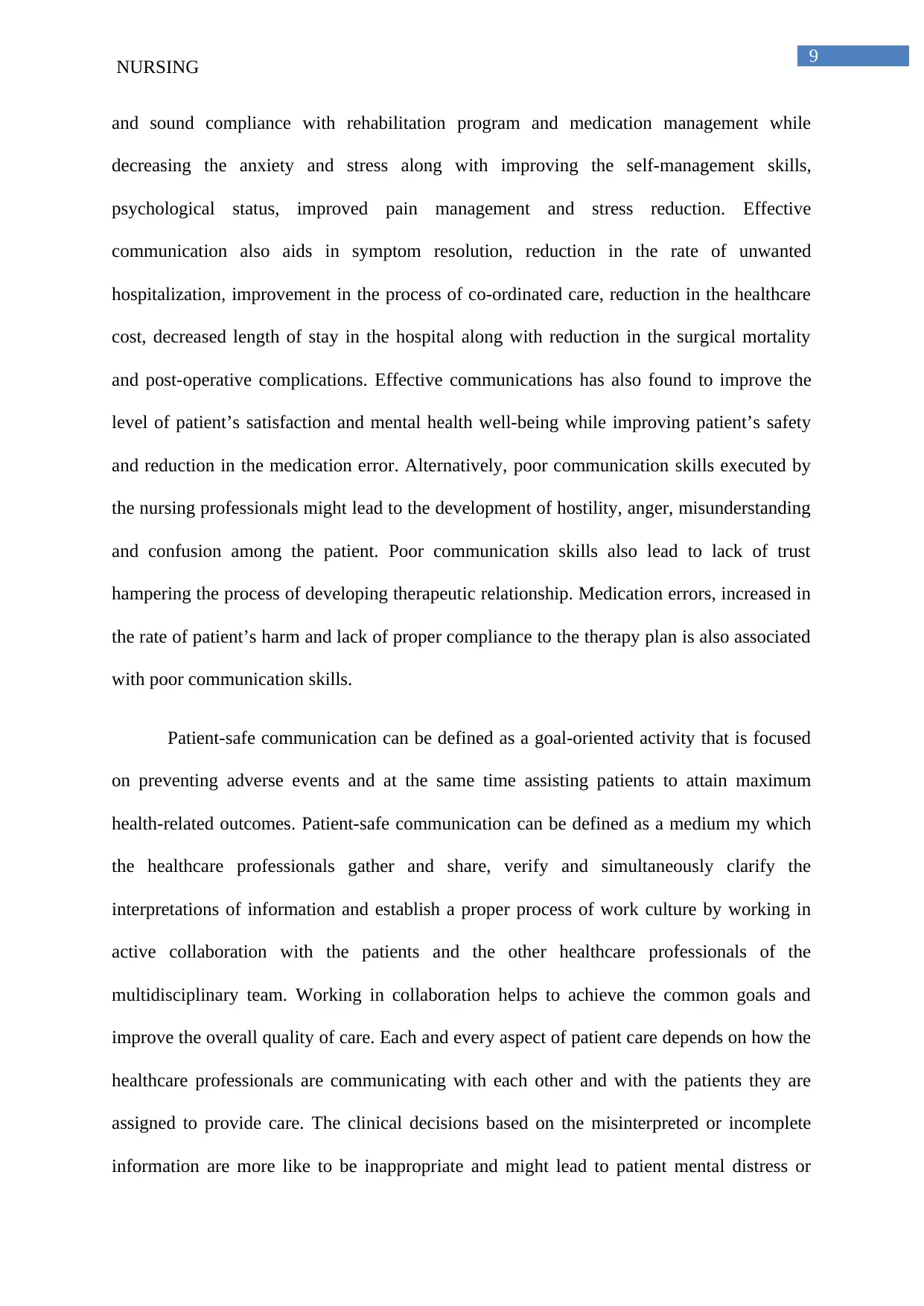
9
NURSING
and sound compliance with rehabilitation program and medication management while
decreasing the anxiety and stress along with improving the self-management skills,
psychological status, improved pain management and stress reduction. Effective
communication also aids in symptom resolution, reduction in the rate of unwanted
hospitalization, improvement in the process of co-ordinated care, reduction in the healthcare
cost, decreased length of stay in the hospital along with reduction in the surgical mortality
and post-operative complications. Effective communications has also found to improve the
level of patient’s satisfaction and mental health well-being while improving patient’s safety
and reduction in the medication error. Alternatively, poor communication skills executed by
the nursing professionals might lead to the development of hostility, anger, misunderstanding
and confusion among the patient. Poor communication skills also lead to lack of trust
hampering the process of developing therapeutic relationship. Medication errors, increased in
the rate of patient’s harm and lack of proper compliance to the therapy plan is also associated
with poor communication skills.
Patient-safe communication can be defined as a goal-oriented activity that is focused
on preventing adverse events and at the same time assisting patients to attain maximum
health-related outcomes. Patient-safe communication can be defined as a medium my which
the healthcare professionals gather and share, verify and simultaneously clarify the
interpretations of information and establish a proper process of work culture by working in
active collaboration with the patients and the other healthcare professionals of the
multidisciplinary team. Working in collaboration helps to achieve the common goals and
improve the overall quality of care. Each and every aspect of patient care depends on how the
healthcare professionals are communicating with each other and with the patients they are
assigned to provide care. The clinical decisions based on the misinterpreted or incomplete
information are more like to be inappropriate and might lead to patient mental distress or
NURSING
and sound compliance with rehabilitation program and medication management while
decreasing the anxiety and stress along with improving the self-management skills,
psychological status, improved pain management and stress reduction. Effective
communication also aids in symptom resolution, reduction in the rate of unwanted
hospitalization, improvement in the process of co-ordinated care, reduction in the healthcare
cost, decreased length of stay in the hospital along with reduction in the surgical mortality
and post-operative complications. Effective communications has also found to improve the
level of patient’s satisfaction and mental health well-being while improving patient’s safety
and reduction in the medication error. Alternatively, poor communication skills executed by
the nursing professionals might lead to the development of hostility, anger, misunderstanding
and confusion among the patient. Poor communication skills also lead to lack of trust
hampering the process of developing therapeutic relationship. Medication errors, increased in
the rate of patient’s harm and lack of proper compliance to the therapy plan is also associated
with poor communication skills.
Patient-safe communication can be defined as a goal-oriented activity that is focused
on preventing adverse events and at the same time assisting patients to attain maximum
health-related outcomes. Patient-safe communication can be defined as a medium my which
the healthcare professionals gather and share, verify and simultaneously clarify the
interpretations of information and establish a proper process of work culture by working in
active collaboration with the patients and the other healthcare professionals of the
multidisciplinary team. Working in collaboration helps to achieve the common goals and
improve the overall quality of care. Each and every aspect of patient care depends on how the
healthcare professionals are communicating with each other and with the patients they are
assigned to provide care. The clinical decisions based on the misinterpreted or incomplete
information are more like to be inappropriate and might lead to patient mental distress or
Paraphrase This Document
Need a fresh take? Get an instant paraphrase of this document with our AI Paraphraser
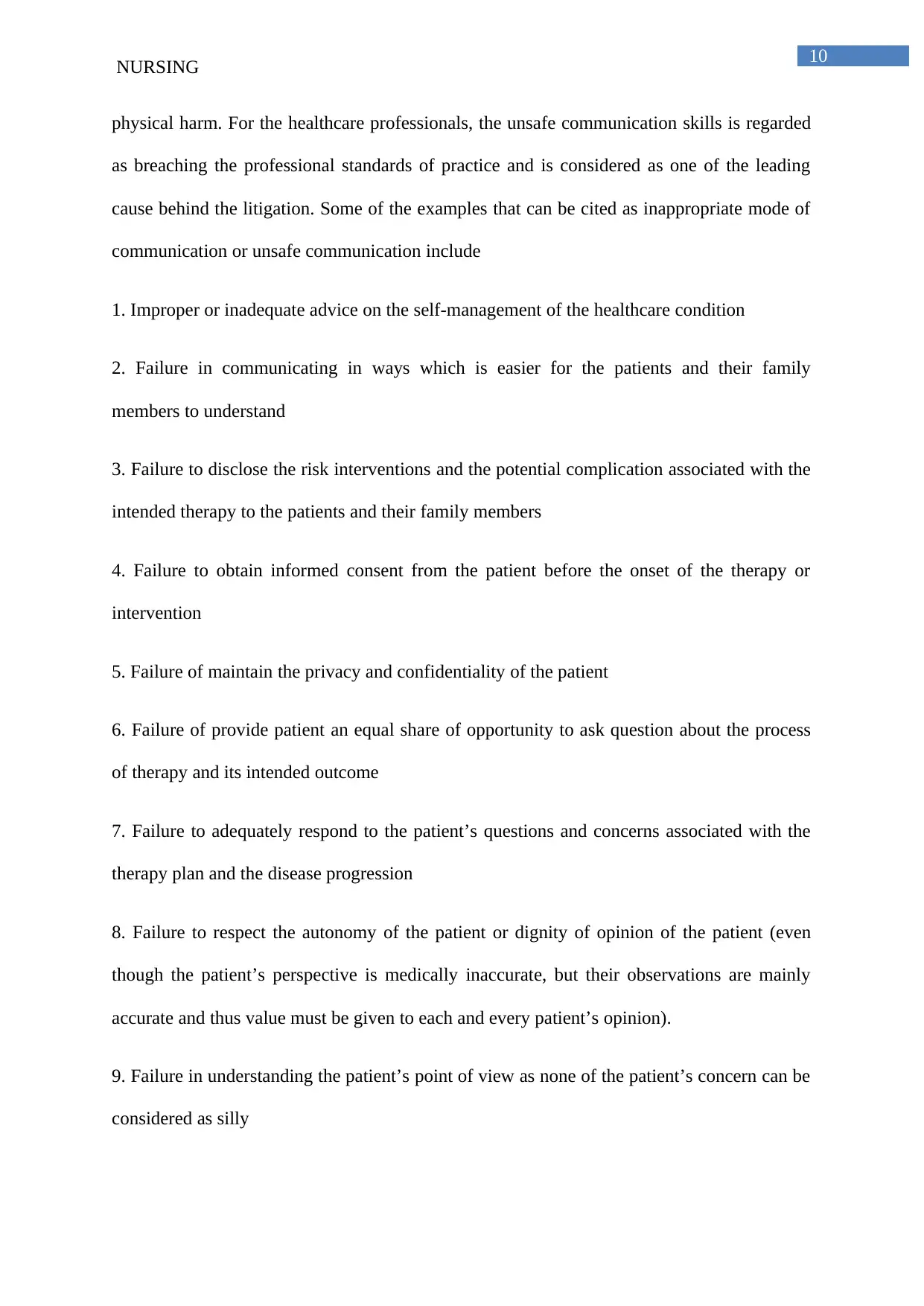
10
NURSING
physical harm. For the healthcare professionals, the unsafe communication skills is regarded
as breaching the professional standards of practice and is considered as one of the leading
cause behind the litigation. Some of the examples that can be cited as inappropriate mode of
communication or unsafe communication include
1. Improper or inadequate advice on the self-management of the healthcare condition
2. Failure in communicating in ways which is easier for the patients and their family
members to understand
3. Failure to disclose the risk interventions and the potential complication associated with the
intended therapy to the patients and their family members
4. Failure to obtain informed consent from the patient before the onset of the therapy or
intervention
5. Failure of maintain the privacy and confidentiality of the patient
6. Failure of provide patient an equal share of opportunity to ask question about the process
of therapy and its intended outcome
7. Failure to adequately respond to the patient’s questions and concerns associated with the
therapy plan and the disease progression
8. Failure to respect the autonomy of the patient or dignity of opinion of the patient (even
though the patient’s perspective is medically inaccurate, but their observations are mainly
accurate and thus value must be given to each and every patient’s opinion).
9. Failure in understanding the patient’s point of view as none of the patient’s concern can be
considered as silly
NURSING
physical harm. For the healthcare professionals, the unsafe communication skills is regarded
as breaching the professional standards of practice and is considered as one of the leading
cause behind the litigation. Some of the examples that can be cited as inappropriate mode of
communication or unsafe communication include
1. Improper or inadequate advice on the self-management of the healthcare condition
2. Failure in communicating in ways which is easier for the patients and their family
members to understand
3. Failure to disclose the risk interventions and the potential complication associated with the
intended therapy to the patients and their family members
4. Failure to obtain informed consent from the patient before the onset of the therapy or
intervention
5. Failure of maintain the privacy and confidentiality of the patient
6. Failure of provide patient an equal share of opportunity to ask question about the process
of therapy and its intended outcome
7. Failure to adequately respond to the patient’s questions and concerns associated with the
therapy plan and the disease progression
8. Failure to respect the autonomy of the patient or dignity of opinion of the patient (even
though the patient’s perspective is medically inaccurate, but their observations are mainly
accurate and thus value must be given to each and every patient’s opinion).
9. Failure in understanding the patient’s point of view as none of the patient’s concern can be
considered as silly
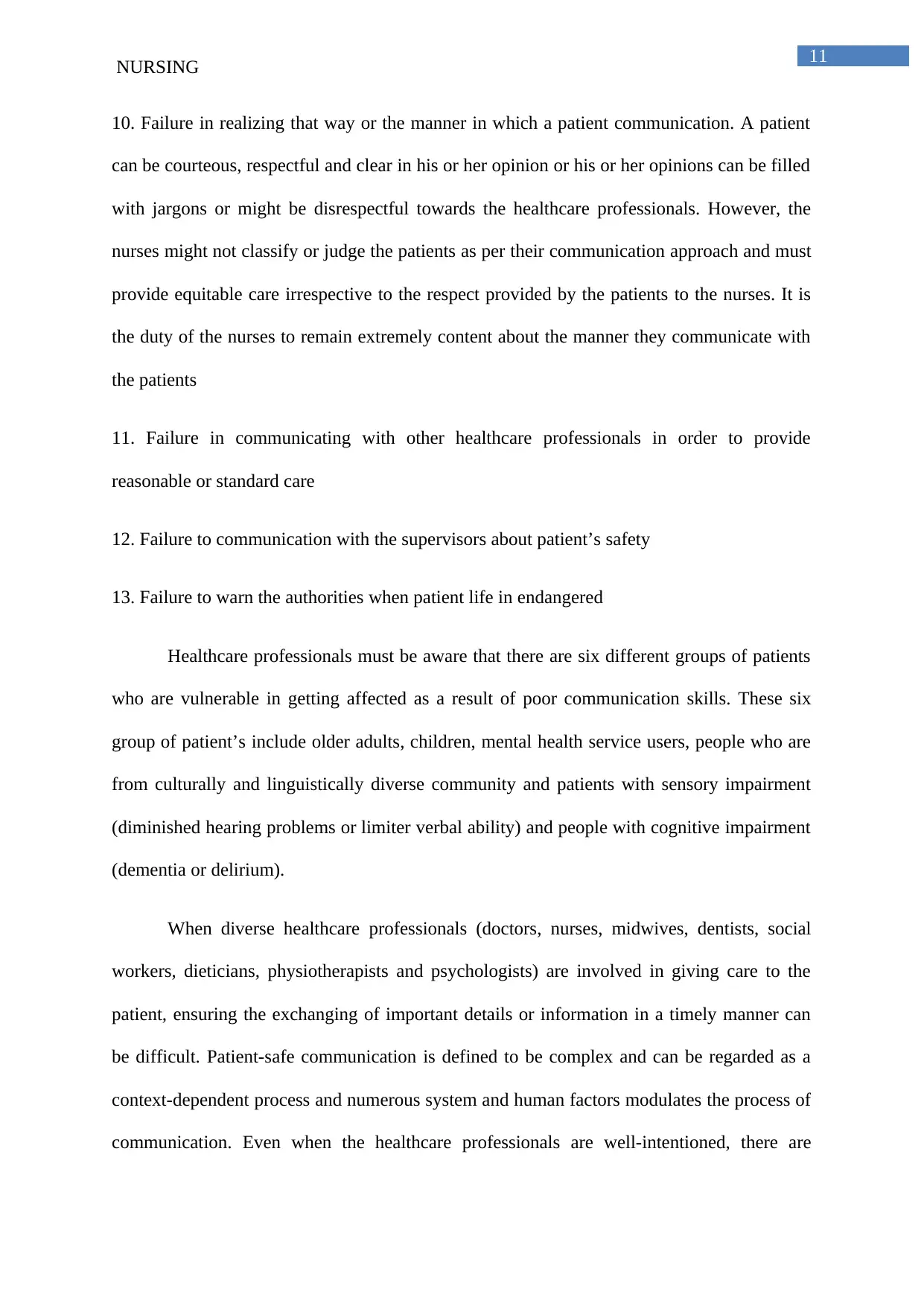
11
NURSING
10. Failure in realizing that way or the manner in which a patient communication. A patient
can be courteous, respectful and clear in his or her opinion or his or her opinions can be filled
with jargons or might be disrespectful towards the healthcare professionals. However, the
nurses might not classify or judge the patients as per their communication approach and must
provide equitable care irrespective to the respect provided by the patients to the nurses. It is
the duty of the nurses to remain extremely content about the manner they communicate with
the patients
11. Failure in communicating with other healthcare professionals in order to provide
reasonable or standard care
12. Failure to communication with the supervisors about patient’s safety
13. Failure to warn the authorities when patient life in endangered
Healthcare professionals must be aware that there are six different groups of patients
who are vulnerable in getting affected as a result of poor communication skills. These six
group of patient’s include older adults, children, mental health service users, people who are
from culturally and linguistically diverse community and patients with sensory impairment
(diminished hearing problems or limiter verbal ability) and people with cognitive impairment
(dementia or delirium).
When diverse healthcare professionals (doctors, nurses, midwives, dentists, social
workers, dieticians, physiotherapists and psychologists) are involved in giving care to the
patient, ensuring the exchanging of important details or information in a timely manner can
be difficult. Patient-safe communication is defined to be complex and can be regarded as a
context-dependent process and numerous system and human factors modulates the process of
communication. Even when the healthcare professionals are well-intentioned, there are
NURSING
10. Failure in realizing that way or the manner in which a patient communication. A patient
can be courteous, respectful and clear in his or her opinion or his or her opinions can be filled
with jargons or might be disrespectful towards the healthcare professionals. However, the
nurses might not classify or judge the patients as per their communication approach and must
provide equitable care irrespective to the respect provided by the patients to the nurses. It is
the duty of the nurses to remain extremely content about the manner they communicate with
the patients
11. Failure in communicating with other healthcare professionals in order to provide
reasonable or standard care
12. Failure to communication with the supervisors about patient’s safety
13. Failure to warn the authorities when patient life in endangered
Healthcare professionals must be aware that there are six different groups of patients
who are vulnerable in getting affected as a result of poor communication skills. These six
group of patient’s include older adults, children, mental health service users, people who are
from culturally and linguistically diverse community and patients with sensory impairment
(diminished hearing problems or limiter verbal ability) and people with cognitive impairment
(dementia or delirium).
When diverse healthcare professionals (doctors, nurses, midwives, dentists, social
workers, dieticians, physiotherapists and psychologists) are involved in giving care to the
patient, ensuring the exchanging of important details or information in a timely manner can
be difficult. Patient-safe communication is defined to be complex and can be regarded as a
context-dependent process and numerous system and human factors modulates the process of
communication. Even when the healthcare professionals are well-intentioned, there are
⊘ This is a preview!⊘
Do you want full access?
Subscribe today to unlock all pages.

Trusted by 1+ million students worldwide
1 out of 13
Related Documents
Your All-in-One AI-Powered Toolkit for Academic Success.
+13062052269
info@desklib.com
Available 24*7 on WhatsApp / Email
![[object Object]](/_next/static/media/star-bottom.7253800d.svg)
Unlock your academic potential
Copyright © 2020–2025 A2Z Services. All Rights Reserved. Developed and managed by ZUCOL.





